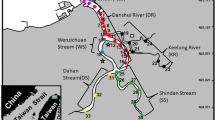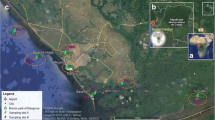Abstract
Persistent organic pollutants (POPs) comprise an array of organic pollutants, renowned for their toxicity and bioaccumulation potential. These POPs exist in abundance in the coastal and estuarine sediments, water column, and biotas, which are impacted by city sewage, agricultural runoffs, aquaculture practices, and others. This chapter summarized the findings from existing literature about the distribution and range of the principal classes of POPs. We considered dichlorodiphenyltrichloroethane and its metabolites (DDTs) and the isomers of hexachlorocyclohexanes (HCHs) as the main organochlorine pesticides (OCPs). We also discussed the congeners of polychlorinated biphenyls (PCBs), polycyclic aromatic hydrocarbons (PAHs), and polybrominated diphenyl ethers (PBDEs). The present chapter focused on the POP accumulation in the sediments, water column, and selected biotas in the estuaries along the east coast of India. Overall, these estuaries exhibited an abundance of HCHs and DDTs with negligible to moderate pollution levels of PCBs, PAHs, and PBDEs. The pollution led by HCHs and DDTs was found to be significantly high in northern estuaries like that of Hooghly and Sundarban estuaries, compared to the southern estuaries like Vellar, Cauvery, and Coleroon estuaries of the east coast of India.
Access this chapter
Tax calculation will be finalised at checkout
Purchases are for personal use only
Similar content being viewed by others
References
Alharbi OM, Khattab RA, Ali I (2018) Health and environmental effects of persistent organic pollutants. J Mol Liq 263:442–453
Balu S, Bhunia S, Gachhui R, Mukherjee J (2020) Assessment of polycyclic aromatic hydrocarbon contamination in the Sundarbans, the world’s largest tidal mangrove forest and indigenous microbial mixed biofilm-based removal of the contaminants. Environ Pollut 266:115270. https://doi.org/10.1016/j.envpol.2020.115270
Binelli A, Sarkar SK, Chatterjee M et al (2007) Concentration of polybrominated diphenyl ethers (PBDEs) in Sundarban mangrove wetland, northeastern part of bay of Bengal (India). Mar Pollut Bull 54:1220–1229
Binelli A, Sarkar SK, Chatterjee M et al (2008) A comparison of sediment quality guidelines for toxicity assessment in the Sunderban wetlands (bay of Bengal, India). Chemosphere 73(7):1129–1137
Crinnion WJ (2011) Polychlorinated biphenyls: persistent pollutants with immunological, neurological, and endocrinological consequences. Altern Med Rev 16(1):5–13
Goswami P, Ohura T, Guruge KS et al (2016) Spatio-temporal distribution, source, and genotoxic potential of polycyclic aromatic hydrocarbons in estuarine and riverine sediments from southern India. Ecotoxicol Environ Safety 130:113–123
Guzzella L, Roscioli C, Vigano L et al (2005) Evaluation of the concentration of HCH, DDT, HCB, PCB and PAH in the sediments along the lower stretch of Hugli estuary, West Bengal, Northeast India. Environ Int 31:523–534
Kannan K, Ramu K, Kajiwara N et al (2005) Organochlorine pesticides, polychlorinated biphenyls and polybrominated diphenyl ethers in Irrawaddy dolphins from India. Arch Environ Contam Toxicol 49:415–420
Karuppiah S, Subramanium A, Obbard JP (2005) Organochlorine residues in odontocete species from the southeast coast of India. Chemosphere 60:891–897
Kumarasamy P, Govindaraj S, Vignesh S et al (2012) Anthropogenic nexus on organochlorine pesticide pollution: a case study with Tamiraparani river basin, South India. Environ Monit Assess 184(6):3861–3873
Lallas PL (2001) The Stockholm convention on persistent organic pollutants. Am J Int Law 95(3):692–708
Ljunggren SA, Helmfrid I, Salihovic S et al (2014) Persistent organic pollutants distribution in lipoprotein fractions in relation to cardiovascular disease and cancer. Environ Int 65:93–99
Mitra S, Corsolini S, Pozo K et al (2019) Characterization, source identification and risk associated with polyaromatic and chlorinated organic contaminants (PAHs, PCBs, PCBzs and OCPs) in the surface sediments of Hooghly estuary, India. Chemosphere 221:154–165
Purkait S, Ganguly M, Aktar MW et al (2009) Impact assessment of various parameters polluting ganga water in Kolkata region: a study for quality evaluation and environmental implication. Environ Monit Assess 155(1–4):443–454
Rajendran RB, Subramanian A (1997) Pesticide residues in water from river Kaveri, South India. Chem Ecol 13(4):223–236
Rajendran RB, Subramanian AN (1999) Chlorinated pesticide residues in surface sediments from the river Kaveri, South India. J Environ Sci Health B 34(2):269–288
Rajendran RB, Imagawa T, Tao H et al (2005) Distribution of PCBs, HCHs and DDTs, and their ecotoxicological implications in bay of Bengal, India. Environ Int 31(4):503–512
Sarkar SK, Binelli A, Riva C et al (2008) Organochlorine pesticide residues in sediment cores of Sunderban wetland, north eastern part of bay of Bengal, India and their ecotoxicological significance. Arch Environ Contam Toxicol 55:358–371
Sarkar SK, Satpathy KK, Jonathan MP et al (2012) Persistent organic pollutants (POPs) in sediments and biota in coastal environments of India. In: Lichtfouse E, Schwarzbauer J, Robert D (eds) Environmental chemistry for a sustainable world. Springer, Dordrecht, pp 375–406
Sarker S, Vashistha D, Sarker MS, Sarkar A (2018) DNA damage in marine rock oyster (Saccostrea Cucullata) exposed to environmentally available PAHs and heavy metals along the Arabian Sea coast. Ecotoxicol Environ Safety 151:132–143
Scheringer M (2009) Long-range transport of organic chemicals in the environment. Environ Toxicol Chem Int J 28(4):677–690
Stranberg B, Van Bavel B, Bergavist PA et al (1998) Occurrence, sedimentation and spatial variations of organochlorine contaminants in settling particulate matter and sediments in the northern part of the Baltic Sea. Environ Sci Technol 32:1754–1759
Venugopalan VK, Rajendran N (1984) Pesticide pollution effects on marine and estuarine resources. DAE research project report, Centre for Advanced Study in Marine Biology, Annamalai University, Parangipettai, pp 1–316
Vizcaino E, Grimalt JO, Fernández-Somoano A, Tardon A (2014) Transport of persistent organic pollutants across the human placenta. Environ Int 65:107–115
Walker CH (2008) Organic pollutants: an ecotoxicological perspective. CRC Press, Boca Raton, USA
Yu HY, Guo Y, Zeng EY (2010) Dietary intake of persistent organic pollutants and potential health risks via consumption of global aquatic products. Environ Toxicol Chem 29(10):2135–2142
Zanardi-Lamardo E, Mitra S, Vieira-Campos AA et al (2019) Distribution and sources of organic contaminants in surface sediments of Hooghly river estuary and Sundarban mangrove, eastern coast of India. Mar Pollut Bull 146:39–49
Zuloaga O, Prieto A, Usobiaga A et al (2009) Polycyclic aromatic hydrocarbons in intertidal marine bivalves of Sunderban mangrove wetland, India: an approach to bioindicator species. Water Air Soil Pollut 201:305–318
Author information
Authors and Affiliations
Editor information
Editors and Affiliations
Rights and permissions
Copyright information
© 2021 The Author(s), under exclusive license to Springer Nature Switzerland AG
About this chapter
Cite this chapter
Basu, S., Chanda, A., Das, S., Bhattacharyya, S. (2021). Persistent Organic Pollutants in the Coastal and Estuarine Regions Adjoining the Indian Periphery of the Bay of Bengal. In: Das, S., Ghosh, T. (eds) Estuarine Biogeochemical Dynamics of the East Coast of India. Springer, Cham. https://doi.org/10.1007/978-3-030-68980-3_7
Download citation
DOI: https://doi.org/10.1007/978-3-030-68980-3_7
Published:
Publisher Name: Springer, Cham
Print ISBN: 978-3-030-68979-7
Online ISBN: 978-3-030-68980-3
eBook Packages: Earth and Environmental ScienceEarth and Environmental Science (R0)




